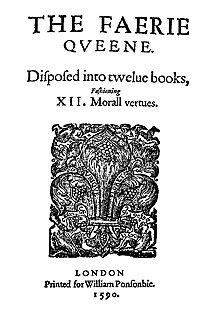
Back ملكة الجن Arabic Кралицата на феите Bulgarian দ্য ফেয়ারি কুইন Bengali/Bangla The Faerie Queene Breton La Reina Fada Catalan Η Νεραϊδοβασίλισσα Greek The Faerie Queene Esperanto La Reina Hada Spanish ملکه پریان Persian The Faerie Queene Finnish
| The Faerie Queene | |
|---|---|
| by Edmund Spenser | |
 Title page of The Faerie Queene, c. 1590 | |
| Country | Kingdom of England |
| Language | Early Modern English |
| Genre(s) | Epic poem |
| Publication date | 1590, 1596 |
| Lines | Over 36,000 |
| Metre | Spenserian stanza |
The Faerie Queene is an English epic poem by Edmund Spenser. Books I–III were first published in 1590, then republished in 1596 together with books IV–VI. The Faerie Queene is notable for its form: at over 36,000 lines and over 4,000 stanzas,[1] it is one of the longest poems in the English language; it is also the work in which Spenser invented the verse form known as the Spenserian stanza.[2] On a literal level, the poem follows several knights as a means to examine different virtues. The poem is also an allegorical work. As such, it can be read on several levels, including as praise (or, later, criticism) of Queen Elizabeth I. In Spenser's "Letter of the Authors", he states that the entire epic poem is "cloudily enwrapped in Allegorical devices", and that the aim of publishing The Faerie Queene was to "fashion a gentleman or noble person in virtuous and gentle discipline".[3]
Spenser presented the first three books of The Faerie Queene to Elizabeth I in 1589, probably sponsored by Walter Raleigh. The poem was a clear effort to gain court favour, and as a reward Elizabeth granted Spenser a pension for life amounting to £50 a year,[4] though there is no further evidence that Elizabeth ever read any of the poem. This royal patronage elevated the poem to a level of success that made it Spenser's defining work.[5]
- ^ Wilkinson, Hazel (2017). Edmund Spenser and the Eighteenth-Century Book. Cambridge University Press. p. 9. ISBN 9781107199552. Retrieved 7 June 2021.
- ^ Loewenstein & Mueller 2003, p. 369.
- ^ Spenser 1984, pp. 15–16.
- ^ Kaske, Carol V., ed. (2006). Spenser's The Faerie Queene Book One. Indianapolis: Hackett. p. 210. ISBN 978-0-87220-808-7.
- ^ Roche 1984, p. 11.